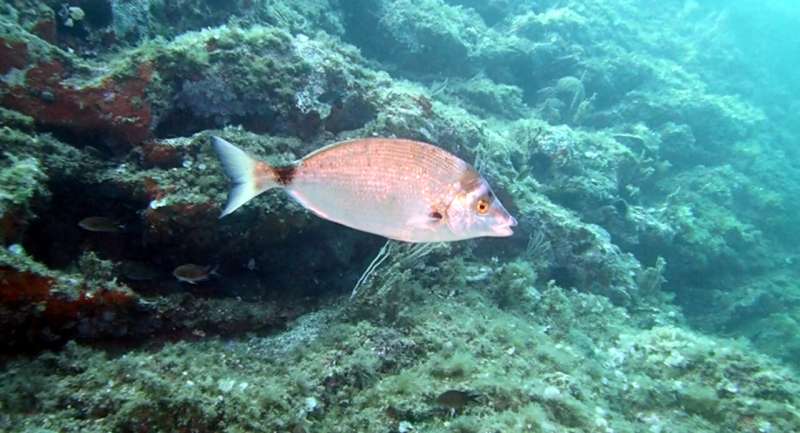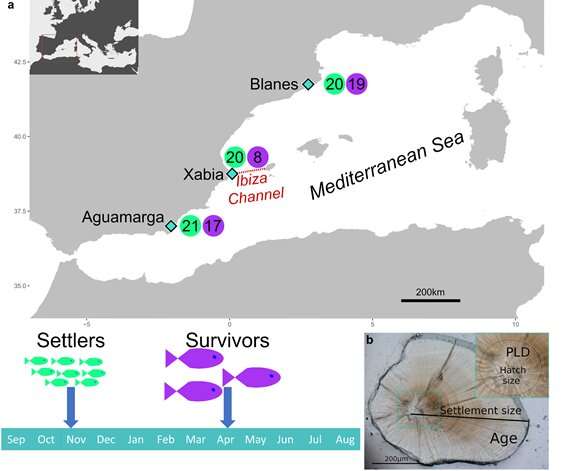Sharpsnout seabream's mortality during early life stages shown to have genetic base

The high mortality in the early stages of life is a common phenomenon in fish and other species, but it is little studied due to its complexity. A study by the University of Barcelona and the Center for Advanced Studies of Blanes (CEAB-CSIC) has analyzed whether this mortality in the sharpsnout seabream (Diplodus puntazzo), a species of the Mediterranean with an important commercial interest, occurs by chance or whether it is genetically determined.
The results, published in the journal Scientific Reports, show that the survival of this fish in the first months has a genetic basis and it is associated with the time of birth.
The study is led by Marta Pascual, lecturer at the Faculty of Biology and member of the Biodiversity Research Institute (IRBio) of the UB and Enrique Machpherson, research professor at CEAB-CSIC. Among the participants of the study are Héctor Torrado (CEAB-CSIC and IRBio), Cinta Pegueroles (IRBio), Carlos Carreras (IRBio) and Nuria Raventós (CEAB-CSIC).
A species with an important ecological role
The sharpsnout seabream is an animal that lives in rocky coastal reefs and seagrass meadows in the Mediterranean and the eastern Atlantic, where it plays a key ecological role, since it is the only Mediterranean fish with a wide prey spectrum, including preys such as sponges, echinoderms and coelenterates. In order to find out the causes for its mortality during the early stages of life, the researchers compared genomic data to phenotypic and environmental data from recruits, individuals that only settled in October after being larvae in the plankton, and survivors, six-month-old fish that had survived the winter.
The researchers analyzed a total of 105 individuals from three populations along a geographical gradient, in particular in the coastal areas of Blanes, Jávea and Agua Amarga. "Analyzing in three different populations the individuals that settle for the first time and those that survive enabled us to identify parallel evolutionary processes associated with environmental and phenotypical variables," the researchers note.
The information on the analyzed fish and the environments was inferred using the analysis of its otoliths, bones in the inner part of the ear. "These are bone structures that show daily growth rings that allow us to see when it catches an individual, a series of variables like when it was born and its size, when it settled and what growth rate it will have or how many days it was in the plankton; they also allow us to record environmental variables of the temperature and the lunar cycles," they say.
The individuals that survive are the ones who are born later
The results showed clear signs of selective mortality mostly associated with birth time, sea surface temperature and growth rate during the larval stage. "It is very interesting to see that in this species, which reproduces in late summer and early autumn, the individuals that survive best are those that are born later, in cooler conditions, and grow more slowly, and mostly, that genetics is important in that survival," they add.

Using sequencing techniques, 122 loci were found to be significantly associated with these phenotypic and environmental variables in parallel in the three populations analyzed. Finding parallel genomic changes between these populations supports the idea of a genetic basis for this mortality during the first six months of life. "Our study is the first to do a genomic approach and in different localities. It is very important to have this sampling, as it shows that the results cannot be due to chance," they write. "Therefore, we treat different populations as survival replicates and look mostly at changes in the same direction.
A pioneering methodology
The methodology used in this study offers a prototype for future genomic and ecological studies of this and other species which will enable the researchers to assess the causes that determine selective mortality in a wild state during this early stage.
"To date, there were no studies that combined the methodologies and types of sampling we used. Our study sets the bases to analyze the survival in early stages in nature, to determine whether this process is by chance or whether it is genetically determined and to understand with long-term studies how polymorphisms are maintained in the populations in the presence of selection," the researchers note.
Sequencing project for the genome of the sharpsnout seabream genome
Although there is a high number of identified loci associated with these features, most of them have not been localized in the closest available genome to the sharpsnout seabream, which suggests that they are in poorly conserved regions and that it is necessary to have phylogenetically closer genomes for comparison.
In this sense, one of the co-authors of the study, IRBio researcher Carlos Carreras, has led a study by the Catalan Initiative for the Earth Biogenome Project to sequence the sharpsnout seabream and it is currently under the annotation phase. "We hope that in the future, this helps us to identify where the loci are and the role they can play in this species' survival," they say.
Studies to analyze interannual variation
The continuation of this study will be to see how selection can change within and between localities and years, as, according to the researchers, there is an interannual variation that can be very important.
"The fact that we have found selective mortality has led us to want to know more. We are not only obtaining the genome of the sharpsnout seabream with the quality of international standards, but we are also analyzing other years. We want to see parallel evolutionary processes, and how they vary over time, as well as to see if there is local adaptation in each population. And, with all of this, we want to identify candidate genes in which we can find out their function," they conclude.
More information: Héctor Torrado et al, Genomic basis for early-life mortality in sharpsnout seabream, Scientific Reports (2022). DOI: 10.1038/s41598-022-21597-3
Journal information: Scientific Reports
Provided by University of Barcelona



















